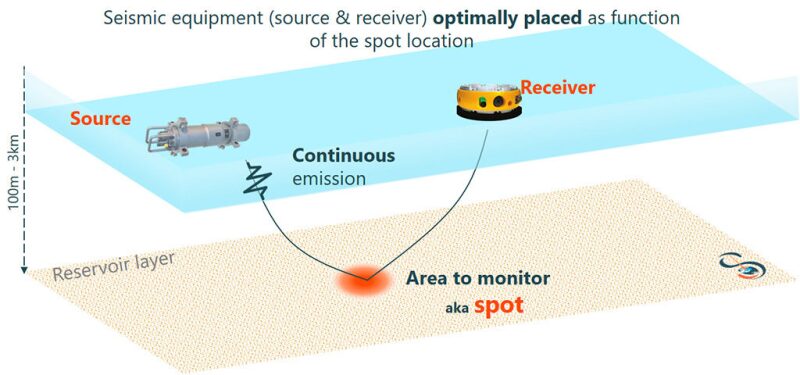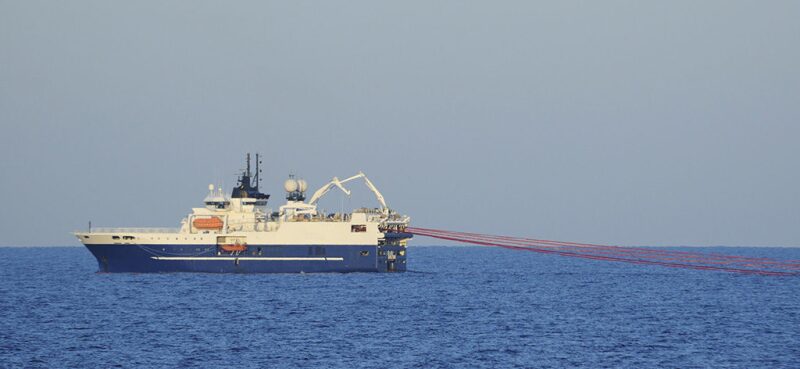A French startup is betting that it can tell offshore producers how good their billion-dollar reservoir predictions really are with its new approach to seismic interpretation. SpotLight—based at a business accelerator on the outskirts of Paris—has introduced the idea that a single seismic source and a single receiver is all you need to know if a critical area in the subsurface is flowing with hydrocarbons, or not.
Outside of direct measurements from wells, one of the only ways to gain dynamic information about the reservoir is through a 4D seismic shoot. Neither cheap nor fast, the 4D process relies on the deployment of a small fleet of vessels to tow miles-long streamers with thousands of receivers, or to install ocean-bottom receiver nodes.
SpotLight wants to go the other direction. Its software will first help decide where to best position the smallest possible seismic set up and then analyzes the acquired data in real time. The deliverable here is the equivalent of 1D seismic—a continuous time-lapse of the pressure changes that signal fluid movement in the subsurface.
This minimalist approach may take just a few days for a cost totaling in the low thousands of dollars. The 4D route typically takes several months to wrap up, and since it is priced by the square kilometer, bills can range between $5-50 million. Spotlight thinks this contrast will sway operators to use its service in the future as the low-cost option for quickly testing the accuracy of their forecasts.
“They know that in their reservoir model things need to happen a certain way, and if it’s not happening that way, then there is a problem,” said Habib Al-Khatib, chief executive officer and founder of SpotLight.
While this fluid-migration detection method lacks the detail of a larger and more complex survey, Al-Khatib said the data it analyzes will reveal yes or no answers to some important questions: Is the caprock maintaining integrity, or has the seal been compromised? Has the fault between an injector and a producing well become a thief zone? Is a particular area of the reservoir contributing to production, or is it isolated and needs to be tapped with a satellite well?
“If the reservoir is connected, then you will hear the production noise,” he explained. “It is everything except quiet.”
Founded on Frustration
In his old post, Al-Khatib grew frustrated in seeing that many of the nuances collected from long-term 4D surveys were not being used by reservoir engineers to update their models. “They told us that the information was just too dense,” he said.
If this was the case, then Al-Khatib theorized that smaller data sets would give engineers something easier to digest. The chance to prove it came as the industry downturn led to massive cuts in exploration programs that were especially hard on seismic firms. Al-Khatib was offered, and accepted the terms of a voluntary layoff in late-2016 and used his severance package to launch the startup.

Joining him in the departure from CGG was Élodie Morgan, a geophysicist who has been tasked with solving the math problems needed to turn SpotLight’s ambition into reality. She shared that their simple theory was initially seen as a little too simple.
“The first feedback we got was that this will never work,” she said, noting that the young company has been getting technical advice from a team of experienced seismic experts, including several people from CGG, who initially “told us that this idea is too crazy and that we should not work on it.”
Since then, Morgan said those experts have changed their minds and helped SpotLight attract the attention of a supermajor that is putting the five-person firm through a proof-of-concept trial. While unable to reveal the name of this operator, Spotlight can say that it has been handed seismic data from an onshore field to test its software’s abilities. If the project goes well, the next step could be an offshore test.
How It Works
As its name suggests, SpotLight wants to focus the attention of the 2D surveys on a very tight area measuring 50-300 m in diameter, with a vertical resolution of about 5-25 m. Once the most-telling “spots” are selected, a small-class seismic vessel and a receiver can be put in place. SpotLight does not intend to visualize the data being captured, which frees up the processing to focus on quickly solving for flow or no flow.

Al-Khatib said though this approach would be valuable to an offshore operator, it is likely too niche for bigger seismic companies, such as his former employer, to dedicate resources to fully prove it out. And depending on the outcome of this novel surveying method, he thinks it could be either complimentary or disruptive to the 4D seismic market.
“In some cases, we can validate a prediction scenario and delay a 4D seismic survey,” he said, adding that when the results disagree with the modeling “then the oil and gas client could call for the 4D service sooner than expected to understand what is happening.”


